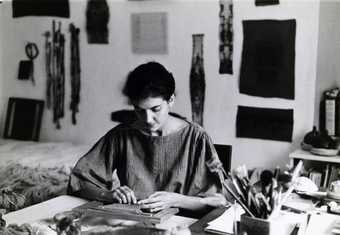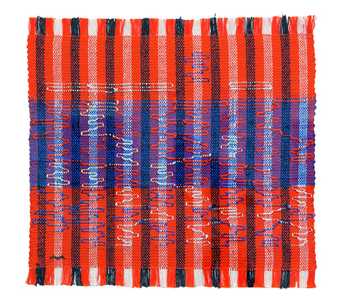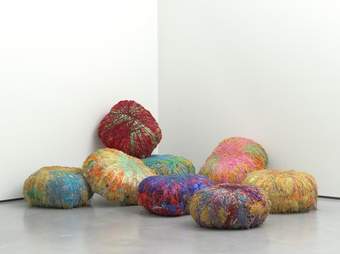
Sheila Hicks weaving at her home in Taxco el Viejo, Mexico, c.1961–2, photographed by Ferdinand Boesch
Courtesy American Craft Council Library & Archive
I’m embarrassed to say I didn’t know who Anni Albers was when I began studying painting at Yale School of Art from 1954 to 1957, but would soon meet her through her husband Josef, who was directing the school. One year, while taking George Kubler’s class on pre-Columbian art, I chose to write a term paper on pre-Incaic Andean textiles. Their ritual burial cloths and mummy bundles had made such a strong impression on me in slide lectures, and when I began writing about them I realised I’d have to learn how they were made as well.
One day Josef saw me sitting on the floor of my painting booth with an improvised backstrap loom that I had made from painting stretchers, tying yarns into tension and trying to figure out the structures and complications of this rich textile language. ‘Was ist das, girl?’, he asked, and told me that he would introduce me to his wife, ‘who is interested in this kind of thing too’. Everything that Albers advised me to do helped me, and this was another of those many things.
He drove me to their modest house in the suburbs of New Haven, a 15-minute journey from the school. After introducing me to Anni, he immediately disappeared downstairs to the basement where, I realised later, he painted. I sat with Anni in the living room on a ripped-out automobile seat that served as a sofa, showing her the experiments I was struggling with.
I remember that she had a small, standing floor loom in a room off to the side of the living room, where she was weaving. Her work didn’t appear to be utilitarian in any way, and it seemed to me that she was giving meaning and expression to this soft, pliable material. I don’t think I understood her work back then, but now I have a better notion of what it was she was doing – her intelligent, technical virtuosity. If Josef had awakened me to the world of colour and ways of using colour in his teaching at the school, I believe that, in the six or seven brief meetings I had with Anni, she helped me to think about structure.
In 1969, an exhibition at MoMA in New York titled Wall Hangings was curated by Mildred Constantine and Jack Lenor Larsen, and featured work by about 30 artists. This was the first time they showed what they called the ‘new textile art’. Anni Albers’s work was included, as was mine. In reality, most of the artists in Wall Hangings had broken out of the tightly focused vision we had inherited from the Bauhaus weavers – things had moved on.
The last time I saw Anni was in the early 1980s, when I was editing and publishing a magazine called American Fabrics and Fashions (AFF). I visited her in her new house in the same area. As I was leaving she surprised me with a very nice gift: a black metal lace bracelet that she told me Edgar Kaufmann Jr (former director of the Department of Industrial Design at MoMA) had brought back for her when he had visited Russia. She was passing this bracelet on to me; I didn’t feel I deserved it. But it was symbolic somehow. I have it still. It’s a precious remembrance of her.
Sheila Hicks is an artist living and working in Paris.


